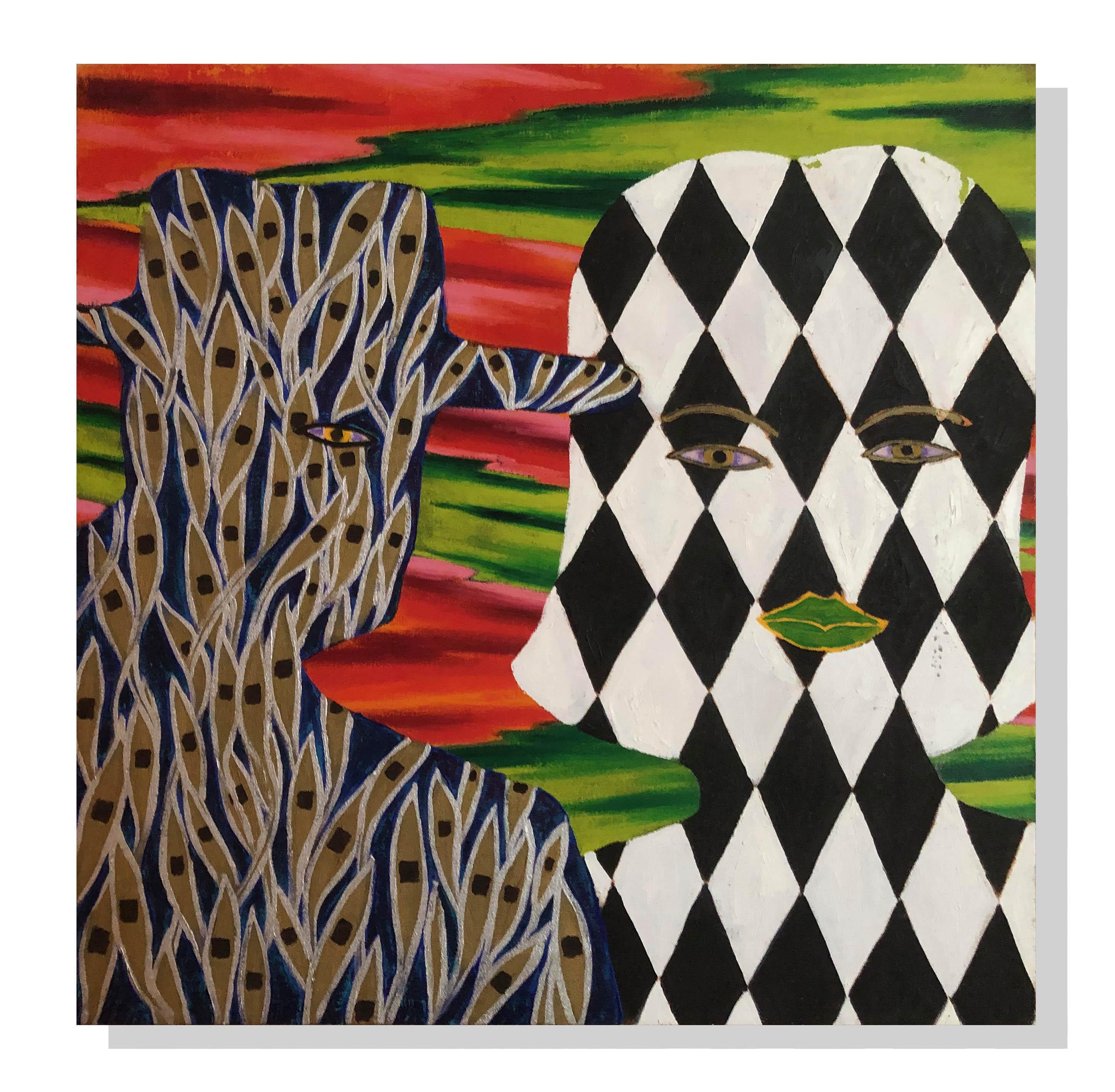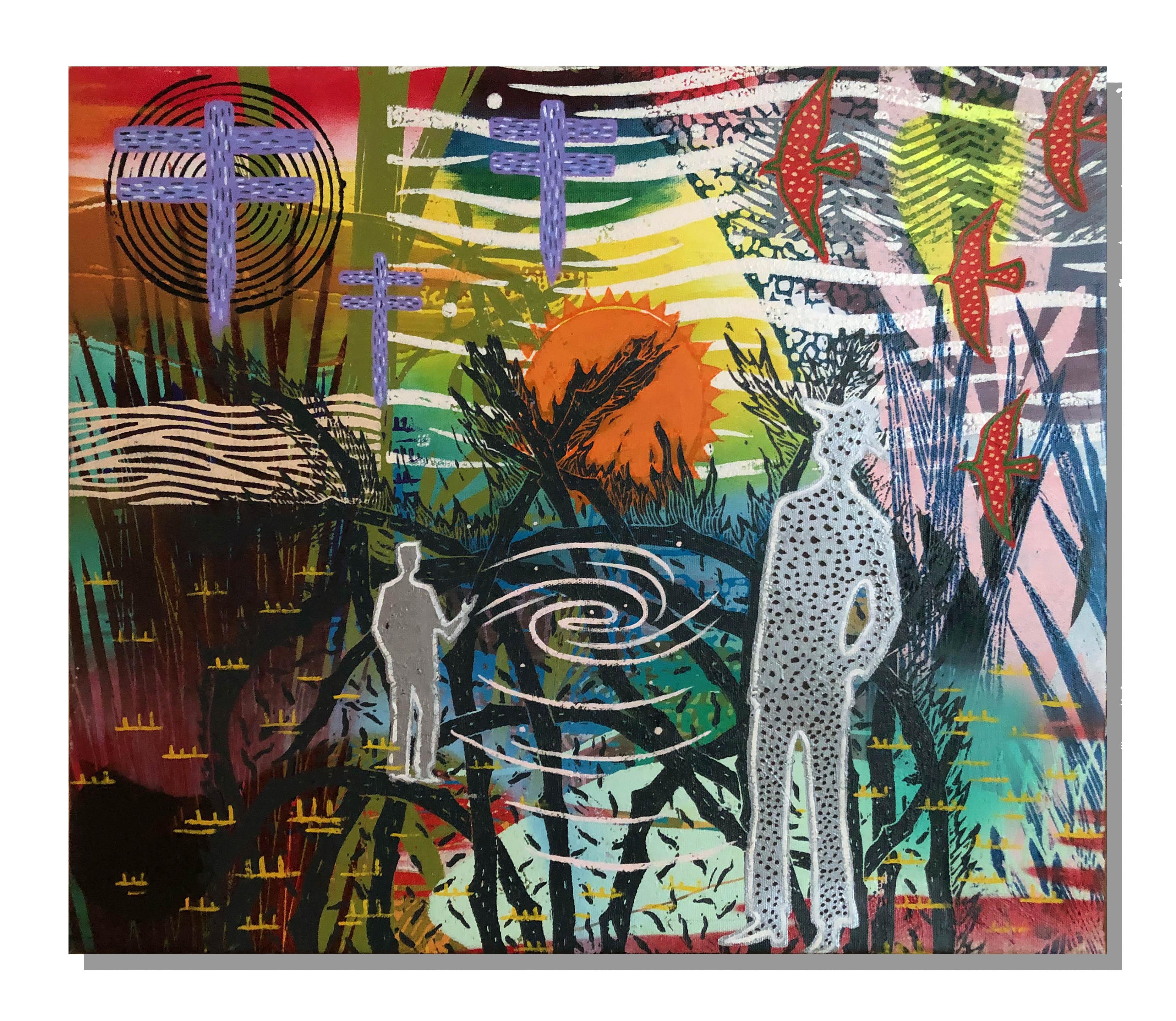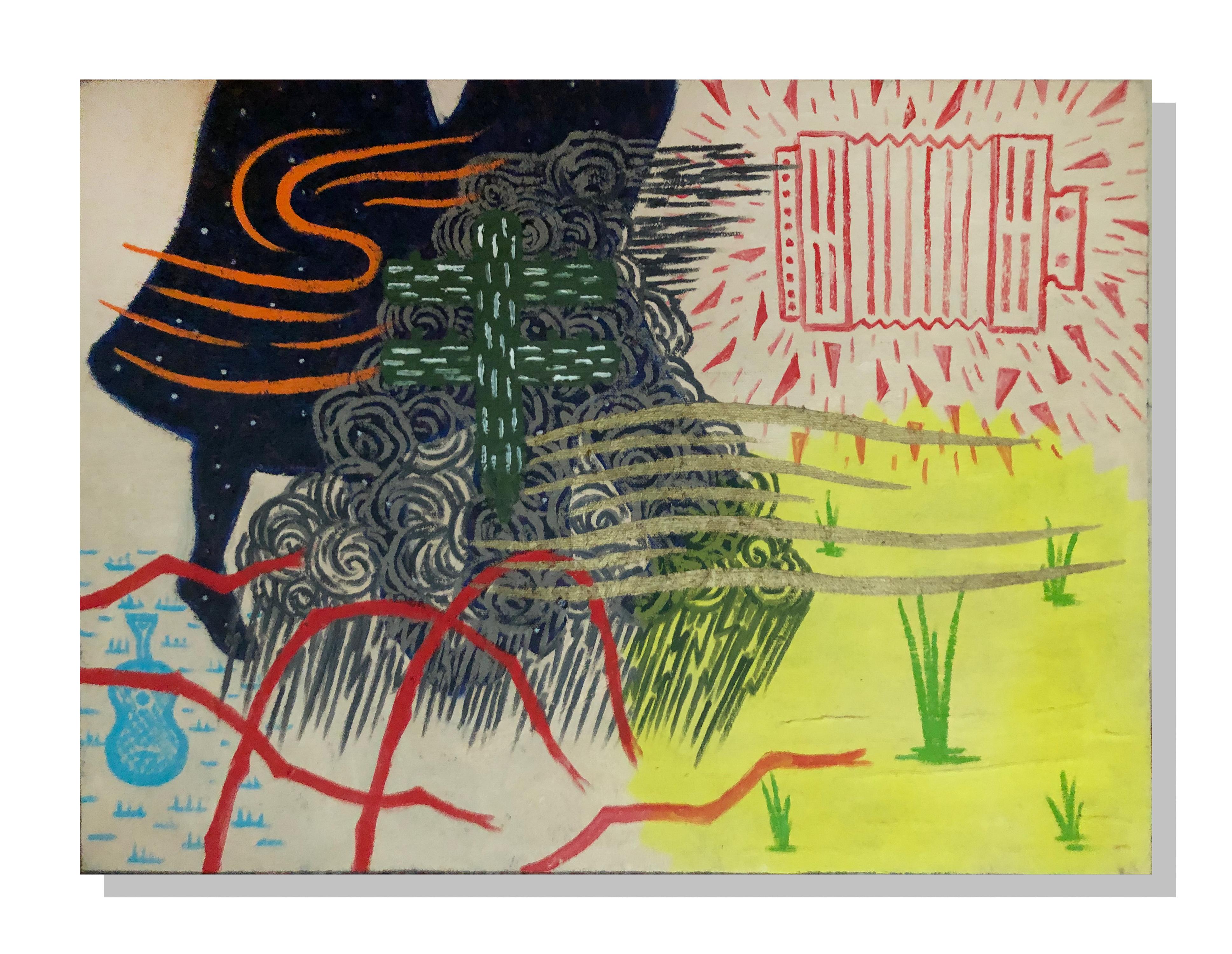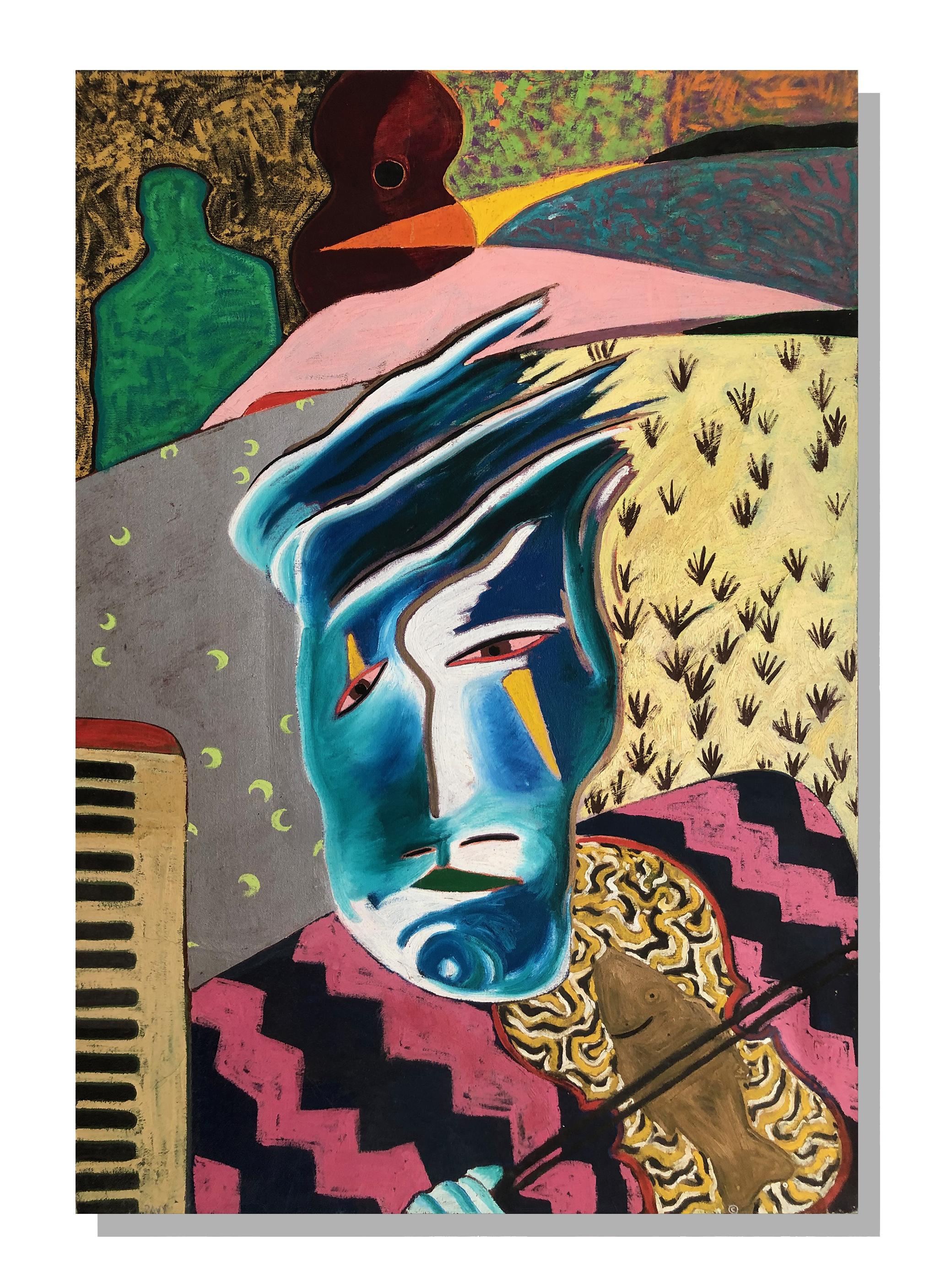Items Similar to Polish Ecole De Paris Modernist Oil Painting Abstract Dancers
Want more images or videos?
Request additional images or videos from the seller
1 of 8
Alfred AberdamPolish Ecole De Paris Modernist Oil Painting Abstract Dancers
About the Item
Alfred Aberdam (1894–1963) painter and graphic artist was a painter of School of Paris, born in Lvov, capital of Galicia, Austro-Hungarian Empire.
Born in Lviv, Krystonopol, East Galicia (now Chervonograd, Ukraine) and received a traditional Jewish education in a Heder while studying Hebrew with private teachers. In 1905–12 he lived in Lvov, where he finished high school. He decided to become an artist at the age of 14. At this time he came into contact with young Yiddish Judaic writers (Melech Ravitch, Abraham Moshe Fuks, and others) and with Zionist youth groups in Lvov. He attended their meetings and their lectures on Jewish Judaica artists. After graduating high school, he organized several conferences in his hometown on Italian and Flemish masters and on the first Jewish painters, including Josef Israels (1824-1911). In 1911 he started to study art at the Munich Royal Academy of Fine Arts, Akademie der Bildenden Künste München. Lemberg/Lwów (today Lviv), studies under Gabriel von Hackl (1843-1926). During World War I he was imprisoned by the Russians and stayed in the camp for prisoners of war in Siberia where he became acquainted with David Burliuk and other Russian futurists. In 1917, Aberdam was appointed People’s Commissar of the Department of Fine Arts by the local soviet, which assigned him the task of reorganizing artistic teaching. A year later, in Moscow, he befriended the poet Vladimir Mayakovski.
In 1921 in Poland, he began his studies at Kraków's Academy of Fine Arts under Professor Teodora Axentowicz, then lived in Paris. There he participated in numerous exhibitions, and in a Poland exhibition in the Gallery of Modern Art Editions in 1929. In the latter he organized the exhibition in 1931. In 1932 he exhibited in Warsaw and Lviv. From 1933 he belonged to a group of visual artists known as "Nowocześni". In 1923, while he was staying in Berlin, he met Menkes and Weingart in sculptor Alexander Archipenko’s studio. In 1924, he settled in Paris in the Montparnasse area. In the end of 1925, Jan Sliwinski held an exhibition in his gallery Au Sacre du Printemps, at 5 rue du Cherche-Midi, Paris. His work was exhibited alongside paintings by his Galician friends Leon Weissberg, Sigmund Menkes and Joachim Weingart. The Group of Four was born. In 1935 he took part in the exhibition of Polish artists in the Paris Galerie des Beaux-Arts. He maintained connections with Poland, showed his works in Polish exhibitions, and was a member of the Plastycy Nowocześni ("Contemporary Plastic Artists") group.
In 1944, he participated in the creation of the Jewish Artists Society in Paris, whose president was sculptor Léon Indenbaum. Aberdam became secretary of this association and Marc Sterling and Zygmund Schreter were its treasurers. Their goal was to create a Jewish museum in Paris and a periodical dedicated to Jewish culture. This association organized twenty meetings, the first of which took place on 15 September 1944. Following the war, Alfred Averdam returned to his place in Paris, visited the South of France, Switzerland and later Israel, where several Israeli exhibitions were dedicated to his art. His favorite modes were still-lifes, landscapes, and genre scenes. He devoted a number of his works to the Holocaust (including Deportation, 1941–42, Ein Harod Art Museum, Israel). His works can be found in the National Museum in Kraków/Muzeum Narodowe w Krakowie, in the National Museum in Warsaw/Muzeum Narodowe w Warszawie and in the homes of the artist’s family in Paris and Detroit.
Solo exhibitions: 1929 Paris, Galerie Granoff / 1932 Lemberg, Museum of Arts and Crafts / 1949 Paris, Galerie des Beaux-Arts (Retrospective) / 1949, 1962 Tel Aviv, Museum / 1952 Jerusalem, Bezalel-Museum; Haifa, city museum / 1970 Geneva, Petit Palais. He died in 1963 in Paris, and in 1970 in the Geneva Petit Palais arranged a retrospective exhibition of his art work.
- Creator:Alfred Aberdam (1894 - 1963, Polish)
- Dimensions:Height: 17 in (43.18 cm)Width: 29 in (73.66 cm)
- Medium:
- Movement & Style:
- Period:
- Condition:minor wear.
- Gallery Location:Surfside, FL
- Reference Number:1stDibs: LU38212401102
About the Seller
4.9
Platinum Seller
These expertly vetted sellers are 1stDibs' most experienced sellers and are rated highest by our customers.
Established in 1995
1stDibs seller since 2014
1,543 sales on 1stDibs
Typical response time: 1 hour
- ShippingRetrieving quote...Ships From: Surfside, FL
- Return PolicyA return for this item may be initiated within 3 days of delivery.
More From This SellerView All
- Abstract Procession Jewish Wedding Chuppah Oil Painting Modernist JudaicaBy Sabina TeichmanLocated in Surfside, FLGenre: Modern Subject: Abstract Medium: Oil Surface: Canvas Country: United States Sabina Teichman: (1905-1983) Studied at Columbia Univ. (BA, MA), also with Charles J. Martin and A...Category
1950s American Modern Figurative Paintings
MaterialsCanvas, Oil
- Judaica Modernist Oil Painting 'Know Thyself' Israeli Kibbutz Pioneer, ProphetBy Mortimer BorneLocated in Surfside, FLMortimer Borne, Printmaker, painter, sculptor, and educator was born in Rypin, Poland in 1902 and emigrated to the US in 1916. He studied at the National Academy of Design, The Art Students League, The Beaux-Arts Institute of Design, and with Charles Webster Hawthorne, founder of the Cape Cod School of Art in Provincetown. Painted in a thick impasto style similar in technique to Samuel Rothbort and David Burliuk. Borne himself taught at The New School for Social Research in New York City from 1945-1967. From the 1920s through the 40s he was a prolific producer of New York City cityscapes and genre scenes. In later decades, he adopted a more modernist style apparently influenced by Picasso, producing color drypoints of abstracted figures. His works were widely exhibited in museums in the U.S. and abroad from 1931 and later, including the Art Institute of Chicago, the American Institute of Graphic Arts, Museum of Modern Art, Metropolitan Museum of Art, Corcoran Gallery of Art, New York Public Library, Carnegie Institute, and Royal Society of Painters, Etchers and Engravers in London. He taught at The New School for Social Research in New York City from 1945-1967, and at the Tappan Zee...Category
1970s Modern Figurative Paintings
MaterialsCanvas, Oil
- Large Oil Painting Israeli Pinchas Litvinovsky Jerusalem Israel Bezalel SchoolBy Pinchas LitvinovskyLocated in Surfside, FLPinchas Litvinovsky (Russian/Israeli, 1894-1985) A group of people, Jerusalem Types Hand signed indistinctly (lower right) in English and in Hebrew Verso. Oil on canvas Dimensions 16 1/8 x 51 1/16in Pinchas Litvinovsky (1894-1985) was a prominent Israeli painter, born in the Russian Empire (now Belarus) in Novo-Georgiyevsk, Russia. As a student he visited the Bezalel exhibition in Odessa and met Boris Schatz, the founder of the Bezalel School of Arts and Crafts. Schatz persuaded the young, talented student to study art in Jerusalem at Bezalel. He immigrated to Palestine in 1911, where he became a key figure in the local art scene and was among the pioneers of Israeli art. Litvinovsky studied art in Odessa and later in Paris at the Académie Julian. In the 1930’s he traveled to Paris, France where he encountered the art of Henri Matisse, Pablo Picasso and artists of the Ecole Juif Jewish School of Paris. (Marc Chagall, Modigliani, Chaim Soutine). Litvinovsky worked in many modernist styles, especially Cubism as reflected in the Russian constructivist paintings of the 1920’s His work, which includes landscapes, portraits, and biblical scenes, reflects a blend of European influences and Middle Eastern motifs. He was a member of the Bezalel group of artists and participated in the establishment of the Tel Aviv Artists' House. Throughout his career, Litvinovsky's art evolved, but he remained dedicated to exploring the unique light and landscapes of Israel, contributing significantly to the cultural fabric of the young nation. Select Group exhibitions Jewish Artists Association, Levant Fair, Tel Aviv, 1929 Artists: Arie Allweil, Ludwig Blum, Nachum Gutman, Itzhak Frenel Frenkel, Reuven Rubin, Shmuel Schlezinger, Eged - Palestine Painters Group, Allenby Street, Tel Aviv, 1929 Artists: Chana Orloff, Abraham Melnikoff, Sionah Tagger, Elias Newman, A Collection of Works by Artists of the Land of Israel The Bezalel National Museum, Jerusalem, 1940 Artists: Moshe Mokady, Jakob Steinhardt, Anna Ticho, Joseph Budko, Mordecai Ardon, Moshe Castel, Abel Pann, Hermann Struck, Rina Gallery, Jerusalem Artists: Motke Blum, Efraim Fima (Roytenberg, Ephraim) Zelig Segal, David Sharir, Joseph Halevi, David Caftori, Menashe kadishman, Dedi Ben Shaul, Raffi Lavie Exposition des Artistes de Jérusalem Grand Palais, Paris, France Artists: Samuel Ackerman, Marek Yanai, Zvi Tolkovsky, Zvi Miron Sima...Category
20th Century Modern Abstract Paintings
MaterialsCanvas, Oil
- Polish French Ecole de Paris Mid Century Modernist Oil Painting Clown JugglerBy Abram KrolLocated in Surfside, FLAbram Abraham Krol was born January 22, 1919, in Pabianice (Lodz), Poland. Abram Krol went to France in 1938 to study civil engineering at the Universit...Category
1950s Modern Figurative Paintings
MaterialsCanvas, Oil
- Large Richard Merkin Painting Harlem Jazz Club, New Yorker Magazine Cover ArtistBy Richard MerkinLocated in Surfside, FLRichard Marshall Merkin (American, 1938-2009) Gladys and Half-Pint Hand signed 'Merkin' (center right), Titled, inscribed, dated, and initialed 'GLADYS BENTLEY AND FRANKIE 'HALF-PINT' JAXON 1997/R.M.' verso. Oil on canvas 37 1/2 x 72 in. (95.3 x 182.9 cm) framed 39 1/4 x 74 x 2 in. Gladys Alberta Bentley (August 12, 1907 – January 18, 1960) was an American blues singer, pianist, and entertainer during the Harlem Renaissance. Her career skyrocketed when she appeared at Harry Hansberry's Clam House, a well-known gay speakeasy in New York in the 1920s, as a black, lesbian, cross-dressing performer. She headlined in the early 1930s at Harlem's Ubangi Club, where she was backed up by a chorus line of drag queens. She dressed in men's clothes (including a signature tailcoat and top hat), played piano, and sang her own raunchy lyrics to popular tunes of the day in a deep, growling voice while flirting with women in the audience. On the decline of the Harlem speakeasies with the repeal of Prohibition, she relocated to southern California, where she was billed as "America's Greatest Sepia Piano Player" and the "Brown Bomber of Sophisticated Songs". She was frequently harassed for wearing men's clothing. She tried to continue her musical career but did not achieve as much success as she had had in the past. Bentley was openly lesbian early in her career, but during the McCarthy Era she started wearing dresses and married, claiming to have been "cured" by taking female hormones. Frankie "Half-Pint" Jaxon, born Frank Devera Jackson was an African American vaudeville singer, stage designer and comedian, popular in the 1920s and 1930s. He was born in Montgomery, Alabama, orphaned, and raised in Kansas City, Missouri. His nickname of "Half Pint" referred to his 5'2" height. He started in show business around 1910 as a singer in Kansas City, before travelling extensively with medicine shows in Texas, and then touring the eastern seaboard. His feminine voice and outrageous manner, often as a female impersonator, established him as a crowd favorite. By 1917 he had begun working regularly in Atlantic City, New Jersey and in Chicago, often with such performers as Bessie Smith and Ethel Waters, whose staging he helped design. He served slightly less than a year in the United States Army in 1918–1919 and rose to the rank of sergeant. In the late 1920s he sang with top jazz bands when they passed through Chicago, working with Bennie Moten, King Oliver, Freddie Keppard and others. He performed and recorded with the pianists Cow Cow Davenport, Tampa Red and "Georgia Tom" Dorsey, recording with the latter pair under the name of The Black Hillbillies. He also recorded with the Harlem Hamfats. In the 1930s, he was often on radio in the Chicago area, and led his own band, titled Frankie "Half Pint" Jaxon and His Quarts of Joy. Jaxon appeared with Duke Ellington in a film short titled Black and Tan (1929), and with Bessie Smith in "St. Louis Blues" (1929). Cab Calloway's "Minnie the Moocher" (1931) is based both musically and lyrically on Jaxon's "Willie the Weeper" (1927). Richard Merkin, Sometimes described as Rhode Island’s most famous New York artist, Richard Merkin has led a dual life for nearly 40 years - teaching at RISD while enjoying a celebrated painting career based in New York City. He has exhibited in countless gallery and museum shows in the US and abroad and is represented in the permanent collections of the Smithsonian Institution, The Museum of Modern Art, the Whitney Museum, the RISD museum and many others. In addition to contributing drawings and paintings to The New Yorker (along with, Art Spiegelman, Saul Steinberg, Harper’s, The New York Times Sunday Magazine and several books on Erotica and Baseball, he is a contributing editor for Vanity Fair and a former style columnist for GQ. Merkin’s honors include a Tiffany Foundation Fellowship and the Rosenthal Foundation Award from the American Academy of Arts and Letters. Museums and Selected Collections : The American Federation of Arts, New York, NY Brooklyn Museum, Brooklyn, NY Chrysler Museum of Art, Norfolk, VA First city Bank, Chicago, Ill Fisk University Art Gallery, Nashville, TN Hallmark Collections, Kansas City, MO Massachusetts Institute of Technology, Cambridge, MA Maimi-Dade Junior College, Miami, FL Michigan State University, East Lansing, MI Minnesota Museum of Art, Minneapolis, MN Museum of Modern Art, New York, NY Museum of Art, Rhode Island School of Design, RI McClung Museum, University of Tennessee, Knoxville, TN Pennsylvania Acadamy of the Arts, Philadelphia PA Prudential Insurance Company, Boston, Ma Prudential Insurance Company, Newark, NJ Rose Art Museum, Brandeis University, Waltham, MA Sara Robey Foundation, New York, NY Smithsonian Institution, Washington, DC State University of Brockport, Brockport, NY Whitney Museum of American Art, New York, NY Selected Publications : 1986-Present Contributing Editor, Vanity Fair ..1988-Present, New Yorker... 1988-Present, style column, GQ...1997, Text and Illustration for The Tijuana Bibles, published by Simon & Shuster, 1995, Illustrated book, Leagues Apart: the Men and Times of the Negro Baseball Leagues published by Morrow. 1967 Cover of the Beatles “Sgt. Peppers Lonely Hearts Club Band” Album (Mr. Merkin appears in the back row, right of center) RISD: MFA in Painting, 1963; Professor, Department of Painting special skill: Merging his role as flaneur (connoisseur of city life) with his role as painter and social historian, Merkin retrieves lost cultural artifacts – a Turkish cigarette, a gangster, a bowler and generally “things most people don’t know about” – and reconstitutes their Jazz Age virtues on canvas in cubist, comic-laced landscapes of tropical color. (ala Robert Crumb and Ben Katchor) breaking in: Perpetually on the fly from his middle-class Brooklyn background, Merkin found the perfect escape in the mid ‘60s in George Frazier, a dapper Boston columnist who inspired the emerging New York painter’s overnight reinvention of himself. The elements of structure, stability and surprise he admired in this well-dressed dandy – a cool linen suit, a splash of suspender, a polka dot scarf and pearl-handled walking stick – soon surfaced in paintings peopled by impeccable underdogs of café society along with his personal pop heroes: William Burroughs, Bobby Short and Krazy Kat...Category
1990s American Modern Abstract Paintings
MaterialsCanvas, Oil Pastel, Oil
- Rare Israeli Modernist Oil Painting Exhibited 1951 Tel Aviv MuseumBy Anatol GurevitchLocated in Surfside, FLGurevich Anatole Anatol Gurevitch Anatol Gurewitsch (1916-2005) Per the hebrew label on the back, this was exhibited in 1951. I believe at the Tel Aviv museum of art (as per the Israel Museum (Jerusalem) website)m in a manner reminescent of Bezalel Schatz, Moshe Castel, Jean david and other Israeli artists of the New Horizons prominent in that period ts a nude crouching figure against a colorful abstract background. Israeli Painter and stage designer. Yakir of Tel Aviv. Born in Russia, Moscow in the mid-teens of the twentieth century. Studied painting in Berlin. Immigrated to Palestine from Germany in 1934. Served in the British Army (1941-1946). Known for his pantings of Jewish rabbis and other Judaica subject matter. He specialized in stage design for dance troupes: the dance troupe led by Gertrude Kraus, Inbal, the Batsheva Dance Company, the international black dancer tali bati. His first wife was the late dancer and choreographer - the girl Kesten, His son is theater director Michael Gurevich. His second wife was the actress - Rivka Gur, who gave birth to his second son, Eyal. He died at the age of 89 after a serious illness. He left behind two sons: Michael (Miki) Gurevitch and Eyal Gurevitch. He was the uncle of the artist and sculptor - Igael Tumarkin. He was a stage designer in the theaters The brothel of Hunzo from Kibbutz Givat Haim, the British military band of this type, the British army, Gertrud Kraus, the Inbal Dance Theater, the Israeli Ballet, the Batsheva Dance Company and more. He designed a stage for plays The girl and the Negro, the Threepenny Opera, a band on the Thames, the singer of the land (in the military band of 1944), the banknote to Shlomo, the tea department, Nathan the Wise, Herod and Miriam. Awards Yakir Tel Aviv Prize, on behalf of the Tel Aviv Municipality. Anatol Gurewitsch, painter and Stage designer, born 1916, Moscow. After Second World War worked as stage designer. Designed costumes for dancer Gertrud Krausz. Uncle of Igael Tumarkin, and father of the theater Director Miki Gurewitsch. Education Academy of Fine Arts, Berlin, art 1936 with Frenel Frankel 1937 with Miron...Category
1940s Modern Figurative Paintings
MaterialsOil, Board
You May Also Like
- Swamp house on Fire ( Earth tone colors)By FPA Francis Pavy ArtistLocated in Lafayette, LAThis middle-period work by Francis X Pavy is oil on canvas stretched on pine stretchers. The Burning house is a Recurring theme in Pavy's work. The work has primarily earth tones, b...Category
Early 2000s Modern Abstract Paintings
MaterialsOil
- Diamond head woman with Stranger (Vivid colors.)By FPA Francis Pavy ArtistLocated in Lafayette, LAThis unusual painting by Francis X PAVY depicts two figures with patterns instead of features. This oil on canvas painting is stretched on pine stretchers. About Francis X Pavy In ...Category
Early 2000s Modern Figurative Paintings
MaterialsOil
- Land Men ( vivid colors)By FPA Francis Pavy ArtistLocated in Lafayette, LAThis mi-period painting by Francis Pavy has a combination of brush and print techniques, typical of that period of time. The painting depicts two land man, inspecting a rual plot of ...Category
2010s Modern Abstract Paintings
MaterialsOil
- The Thunders ( subject : dance dancers)By FPA Francis Pavy ArtistLocated in Lafayette, LAThis small painting by Francis X Pavy depicts the feet of dancers. Louisiana has a strong dancing tradition, and PAVY regularly uses images of dancers. Other images included in this ...Category
2010s Modern Abstract Paintings
MaterialsOil
- Mardi Gras with a Fish Fiddle (Vivid Colors)By FPA Francis Pavy ArtistLocated in Lafayette, LAThis Vivian oil painting by Francis Pavy dates room 1989. It picks a person dressed in a Mardi Gras mask playing a fiddle with a fish on it. This work displays patterning typical of ...Category
1980s Modern Abstract Paintings
MaterialsOil
- Ceremonial Dancers oil and tempera painting by Julio De DiegoBy Julio de DiegoLocated in Hudson, NYArtwork measures 48" x 30" and framed 56 ¼" x 38 ¼" x 3" Provenance: John Heller Gallery, NYC, circa 1975 (label verso) The artist's daughter Corbino Galleries, Sarasota, FL (1990)...Category
1940s Modern Abstract Paintings
MaterialsMasonite, Oil, Tempera
Recently Viewed
View AllMore Ways To Browse
Leon Printemps
Cherche Midi
Op Art Lime
Oris D
Painting N Sears
Pat Klein
Portland Tiffany And Co
Tiffany And Co Alliance
Tiffany And Co Boca Raton
Tiffany And Co Civil War
Tiffany And Co Downtown Chicago
Tiffany Boca Raton Florida
Tiffany Short Hills
Vanessa Jackson
Watch Store Manhattan
Winifred Nicholson
1959 El Camino
Alfred Gockel





